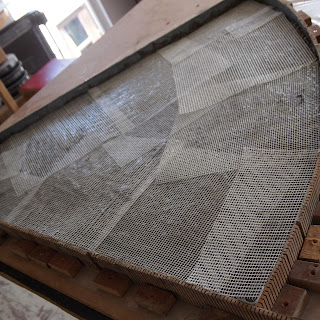AS THE FINAL SECTION COMES OFF THE BENCH I THOUGHT IT MIGHT BE INTERESTING TO SHOW THE CASTING TECHNIQUE.
First photo shows the completed panel on the bench, in reverse. It was made by following a reversed drawing on polythene and attaching the mosaic with Spraymount. Then, using bendy MDF, 50mm walls are made around the mosaic to contain the concrete backing. The walls are held in place with wooden noggins screwed onto the bench and the inner walls are lined with waterproof tape.
First the "goo", a mix of neat Portland cement between all the joints and across the back of the tesserae. Then a layer of the concrete mix (sharp sand, fine aggregate and cement) then a fibre membrane levelled-off with more cement. Covered for three days, then taken out of the mould, flipped over and cleaned. All ready to go!








In metalworking, casting manner a method, wherein liquid metallic is poured right into a mold, that comprises a hole cavity of the desired shape, and then allowed to chill and solidify. The solidified part is also known as a casting, which is ejected or damaged out of the mold to whole the process. Casting is most most likely used for making tricky shapes that may be elaborate or uneconomical to make by using different methods.
ReplyDeleteprofessional resume writing service